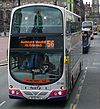
The Trolleybus Museum at Sandtoft is a transport museum which specialises in the preservation of trolleybuses. It is located by the village of Sandtoft, near Belton on the Isle of Axholme in the English county of Lincolnshire.
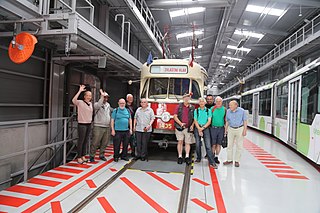
The Scottish Tramway and Transport Society was founded on 27 June 1951 and was the firsty society in the United Kingdom dedicated to tramway retention and preservation. Until 1983 it was known as the Scottish Tramway Museum Society. The Society was originally formed by tramway enthusiasts, mainly living in the Glasgow area, with a view to preserve a Glasgow "Room and Kitchen" type single deck tramcar No. 672 of 1898. The Society was less successful in attempting to preserve an Aberdeen tram. Tram 73 was Aberdeen's last double deck tram with an upper-deck balcony; it was stored for two years until lack of resources led to its scrapping in 1956.
Birmingham City Transport was the local authority-owned undertaking that provided road-based public transport in Birmingham, England, between 1899 and 1969. It was locally known as the Corporation Buses. Initially, it was called Birmingham Corporation Tramways, and, after the first motor bus services started in July 1914, it became Birmingham Corporation Tramways and Omnibus Department in 1928. Finally, in November 1937, it was renamed "Birmingham City Transport", though Birmingham itself had been a City since 1889. It was incorporated into the West Midlands Passenger Transport Executive in 1969.
The Mexborough and Swinton Traction Company was the name adopted by the Mexborough & Swinton Tramways Company in 1929 following the introduction of trolleybuses on all its routes. It operated in the West Riding of Yorkshire, England, over routes serving Manvers Main Colliery, Wath upon Dearne and the towns of Rotherham, Rawmarsh, Swinton, Mexborough, Conisbrough and the estate at Conanby.

Trolleybuses in Wellington were part of the Wellington public transport system from 1924 until 1932 and again from 1949 until 2017. It was the last trolleybus system operating commercially in Oceania and the last major system operating in a country where driving is on the left side of the road.
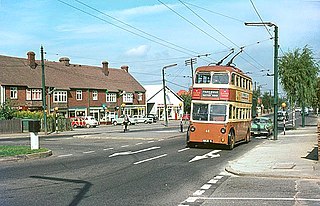
Maidstone Corporation Transport was the operator of trams, trolleybuses and motorbuses in Maidstone, Kent from 1904 to 1974. The operations of Maidstone Corporation passed to Maidstone Borough Council Transport in reorganisation of local government in 1974, expanding the Borough boundaries.
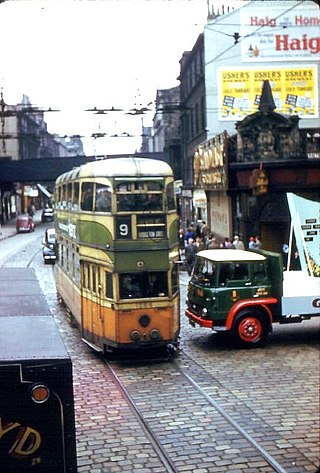
Glasgow Corporation Tramways were formerly one of the largest urban tramway systems in Europe. Over 1000 municipally-owned trams served the city of Glasgow, Scotland, with over 100 route miles by 1922. The system closed in 1962 and was the last city tramway in Great Britain.

The Wolverhampton trolleybus system served the city of Wolverhampton, then in Staffordshire, England, for much of the twentieth century.

Trolleybuses served the London Passenger Transport Area from 1931 until 1962. For much of its existence, the London system was the largest in the world. It peaked at 68 routes, with a maximum fleet of 1,811 trolleybuses.

The Rotherham trolleybus system once served the town of Rotherham, West Riding of Yorkshire, England. Opened on 3 October 1912, it was the fourth trolleybus system to be established in the United Kingdom, after the systems in nearby Bradford and Leeds, which had opened simultaneously in 1911, and Dundee earlier in 1912. Between 1912 and 1949, the Rotherham system gradually replaced the Rotherham Tramway.

The Nottingham trolleybus system once served the city of Nottingham, in the county of Nottinghamshire, England. Opened on 10 April 1927, it gradually replaced the Nottingham tramway network.

The trolleybus system in Manchester, England, opened on 1 March 1938, and gradually replaced certain routes of the Manchester tramway network. Manchester was a belated convert to trolleybuses having already started a programme of tram to diesel bus conversion in the mid-1930s and this, overall, continued to be the preferred option for tram conversion that was completed in 1949.

The Reading trolleybus system served the town of Reading in the English county of Berkshire and was owned by Reading Corporation, who had operated an electric tramway since 1901. As there was a need for major refurbishment of the tramway in the 1930s, they decided to replace it with a trolleybus network. The first route was converted on 18 July 1936, and by mid 1939, trolleybuses were running over most of the tramway routes, with the last tram running on 20 May. By the standards of the various now-defunct trolleybus systems in the United Kingdom, the Reading system was a moderately sized one, with a total of four routes, and a maximum fleet of 63 trolleybuses, a size that lasted from 1 December 1950 to 27 March 1952.
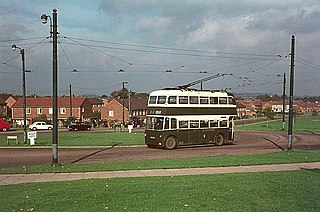
The Derby trolleybus system once served Derby, the former county town of Derbyshire in central England. The trolleybus service started in 1932 and ran until 1967.

The Walsall trolleybus system once served the town of Walsall, then in Staffordshire, but now in West Midlands, England. Opened on 22 July 1931, it gradually replaced the Walsall Corporation Tramways network.

The Ipswich trolleybus system once served Ipswich, the county town of Suffolk, England. Opened on 2 September 1923, it gradually replaced the Ipswich tramway network.

The Cleethorpes trolleybus system once served the holiday resort of Cleethorpes, in Lincolnshire, England. Opened on 18 July 1937, it replaced part of the Great Grimsby Street Tramways, a tramway that had served both Cleethorpes and the neighbouring seaport of Grimsby. It was closed on 4 June 1960.

The Doncaster trolleybus system once served the town of Doncaster, South Yorkshire, England. Opened on 22 August 1928, it gradually replaced the Doncaster Corporation Tramways. By the standards of the various now-defunct trolleybus systems in the United Kingdom, the Doncaster system was a moderately sized one, with a total of 6 routes, all radiating out from the town centre, and a maximum fleet of 47 trolleybuses. The Bentley route was the first to close, on 12 February 1956, and the Beckett Road route was the last to go, on 14 December 1963.

The Neuchâtel trolleybus system is part of the public transport network in Neuchâtel, Switzerland. Opened in 1940, it gradually replaced the urban lines of the Neuchâtel tramway network.

The Hobart trolleybus system operated in Hobart, Tasmania, Australia from 1935 until 1968.





















